Physical Address
304 North Cardinal St.
Dorchester Center, MA 02124
Echocardiography is the primary modality for determining the morphology of the aortic valve and the cause and severity of dysfunction.
In addition to symptoms, quantitative echocardiographic evaluation of left ventricular size and systolic function is key in clinical decision making for adults with aortic valvular heart disease.
Aortic stenosis severity is defined by maximum aortic jet velocity, mean gradient, and continuity equation valve area. The dimensionless velocity index should be also considered, particularly in the absence of good echocardiographic windows.
Aortic regurgitant severity is defined by vena contracta width, the continuous-wave Doppler velocity signal, and presence of aortic flow reversal. In selected cases, calculation of regurgitant volume and regurgitant orifice area is recommended.
Aortic dilation associated with aortic valve disease can be diagnosed by echocardiography, but cross-sectional imaging with gated computed tomography angiography or cardiac magnetic resonance necessary for complete evaluation.
Computed tomography and cardiac magnetic resonance imaging can be used to determine the cause and severity of aortic valve dysfunction when echocardiography is nondiagnostic or there is discrepancy between symptoms and echocardiographic findings.
Primary indications for transesophageal imaging include clarification of aortic valve morphology, quantification of function, and assessment of aortic root morphology. Three-dimensional evaluation of the aortic annulus by transesophageal imaging can be when gated computed tomography angiography is suboptimal for planning of transcatheter aortic valve implantation.
Multiple imaging modalities are used to characterize the morphology and function of the aortic valve and aortic root. Echocardiography remains the primary imaging modality because of ease of use, portability, and high temporal resolution enabling accurate real-time assessment of moving structures and flow in two-dimensional (2D) and three-dimensional (3D) formats. Extensive outcomes data are associated with echocardiographic measurements of ventricular and valvular function. , Nonetheless, cardiac computed tomography (CT) and cardiac magnetic resonance (CMR) imaging offer significant complementary information for the evaluation of patients with aortic valve disease. The advantages and limitations of each modality are discussed.
An understanding of aortic valve and aortic root anatomy is essential to interpret imaging of these structures. The aortic valve complex is composed of the left ventricular outflow tract (LVOT), aortic valve leaflets, and aortic root to the sinotubular junction ( Fig. 8.1 ). An understanding of the complexity of the normal and congenitally abnormal anatomy should start with early development. Early in development, the outflow tract myocardium encases the developing aortic root and regresses as the valvar sinuses develop. The pericardial space no longer has direct continuity with the left ventricular (LV) cavity due to regression of the encasing myocardium, explaining the reflection of the visceral and parietal pericardial surfaces around the aortic root. The mitral-aortic curtain forms in part from the regression of the myocardium in this region, forming a fibrous connection between the mitral valve and the aortic root.
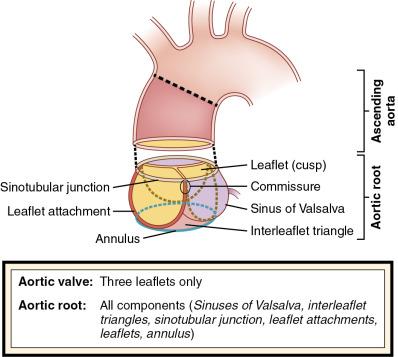
The aortic valve leaflets are semilunar structures supported by the aortic sinuses. Each semilunar cusp is attached to the aortic wall in a curved manner, with the basal attachment located in the LV below the anatomic ventriculoaortic junction and the distal attachment at the sinotubular junction (STJ). When the curved path of the aortic leaflet insertion points are tracked, the 3D spatial configuration of the aortic valve resembles a crown. The STJ is the distal attachment of the leaflet zones of coaptation and is an essential component of valve function; dilation of this structure may lead to malcoaptation and aortic regurgitation (AR). The body of each leaflet extends from the semilunar hinge to the lunula or leaflet edge. Overlap of the lunula ensures a competent valve, but fenestrations may occur with aging and, depending on the extent and location, may result in regurgitation. The proximal and distal attachments of the leaflets are subject to the hemodynamic and anatomic cyclic changes of the ventricle and aorta, respectively.
Coaptation of the three leaflets occurs at no more than one half of the overall height of the aortic root. The fibrous interleaflet triangles between the scalloped hinge lines of the leaflets have as their base the true ventriculoarterial junction, or the plane of mitral-aortic continuity. The top of the triangle is at the level of the STJ. The interleaflet triangles can be easily imaged from the ventricular aspect of the aortic root but not from the aortic side. The membranous septum underlies the right interleaflet triangle between the right and noncoronary cusps. The interleaflet triangles form the boundary between the LV and the extracardiac space; the transverse sinus or the tissue plane separates the aortic root from the free-standing muscular subpulmonary infundibulum.
The aortic valve leaflets are supported by the sinuses of Valsalva. The left coronary sinus is typically the smallest sinus, the right coronary sinus is larger, and the noncoronary sinuses are the largest. The larger sinuses experience increased stress and strain and more commonly exhibit calcification, dilation, or aneurysm formation. The noncoronary sinus also may be referred to as the nonadjacent sinus because it does not border the pulmonary root, unlike the right and left sinuses.
The largest interleaflet triangle is between the noncoronary and left coronary leaflets (triangle between the left and right leaflets is the smallest). There is myocardial support underneath the right and left coronary sinuses, with only fibrous support beneath the noncoronary leaflet. The fibrous support is composed of the central fibrous body (through which runs the atrioventricular bundle of His), the subaortic curtain (in continuity with the anterior mitral leaflet), and the left fibrous trigone. The aortic root changes shape throughout the cardiac cycle, starting as a cone, becoming a cylinder, and then becoming an inverted cone. This ability to change shapes is made possible by the fibrous interleaflet triangles.
According to guidelines, transthoracic echocardiography (TTE) is the diagnostic imaging modality recommended in the initial evaluation of patients with known or suspected aortic valve disease to confirm the diagnosis, establish cause, determine severity, assess hemodynamic consequences, determine prognosis, and evaluate for the timing of intervention.
The aortic valve and root are imaged from multiple standard 2D TTE imaging planes, including: parasternal long- and short-axis views, apical five- and three-chamber views, and subcostal views ( Fig. 8.2 ). When TTE image quality is suboptimal, transesophageal echocardiography (TEE) or CMR may be appropriate. Standard TEE aortic valve imaging planes include: mid-esophageal short- and long-axis views, transgastric long-axis view, and deep transgastric five-chamber view ( Fig. 8.3 ).
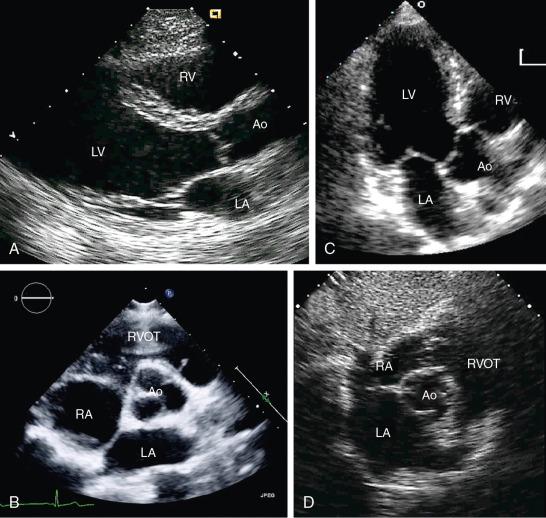
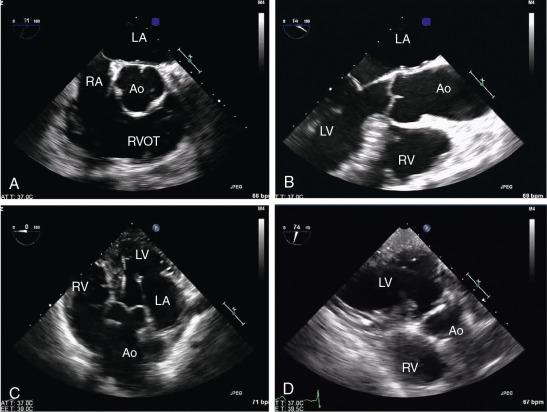
The echocardiographic aortic annulus is a virtual anatomic structure. The plane of the annulus is defined by the three nadirs (most basal) of the semilunar hinge lines of the leaflets, but it has no other anatomic or histologic definition. More than one half of the circumference of the annulus is formed by the base of the interleaflet triangles. The annulus expands by up to one sixth during ventricular ejection; it is the largest and most circular in mid-systole, becoming smallest and most elliptical at end-diastole.
Accurate and reproducible measurement of the diameter of this virtual ring by 2D TTE is not feasible for two reasons. First, with a trileaflet aortic valve, any long-axis plane bisecting a cusp hinge point on one side does not image a hinge point on the other side, but rather images a region of fibrous tissue between the scalloped cusps. Second, the annulus is often asymmetric and oval, with annular diameters largest in the coronal plane and shortest in the sagittal plane. , , Aligning long-axis views to bisect the largest diameter of the annulus or LVOT is essential to accurate measurement of these structures. The use of simultaneous biplane imaging, a 3D matrix probe function, can help identify the optimal location for these measurements.
Several 3D echo studies have advanced our understanding of the aortic valve complex anatomy, including the shape of the LVOT and annulus, , , , aortic root, , and aortic valve leaflets. , The American Society of Echocardiography produced guidelines for standard 3D acquisition and display of the aortic valve ( Fig. 8.4 ). After the 2D image is optimized, narrow-angle or wide-angle (user-defined) acquisition modes can be used to optimize the 3D image and to examine aortic valve and root anatomy. 3D TTE acquisitions are obtained from the parasternal long-axis view with and without color (i.e., narrow angle and zoomed acquisitions). 3D TEE volumes are obtained from a 60-degree, mid-esophageal, short-axis view with and without color (i.e., zoomed or full-volume acquisition) and from a 120-degree, mid-esophageal, long-axis view with and without color (i.e., zoomed or full-volume acquisition).
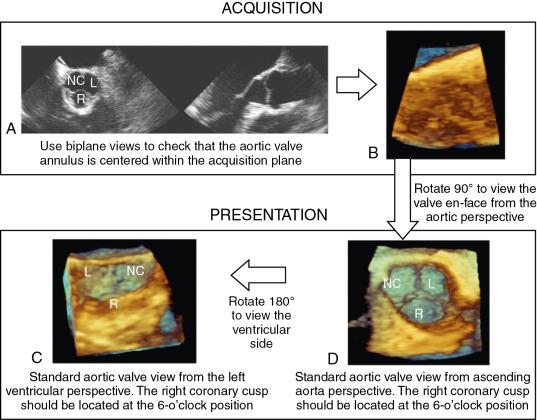
After acquisition, when displayed en face , the aortic valve should be oriented with the right coronary cusp located inferiorly, regardless of whether the aortic or the LVOT perspective is presented. Color Doppler 3D TEE imaging should also be performed to detect the initial appearance of flow at the onset of systole.
The use of cross-sectional imaging for patients with normal aortic valve is typically not recommended unless echocardiographic windows are suboptimal or there is a discrepancy between symptoms or echocardiographic findings, or both. Both gated computed tomography angiography (CTA) and CMR can provide unparalleled visualization of the aortic valve morphology and function, but CTA requires intravenous access for contrast administration, a small radiation dose, and heart rate control. CMR can visualize the aortic valve without radiation, intravenous contrast, or heart rate control, but it cannot visualize calcification well. Both imaging modalities are excellent for visualization and quantification of aortopathy, which can be seen in some cases even in the absence of significant aortic valve pathology ( Fig. 8.5 ).
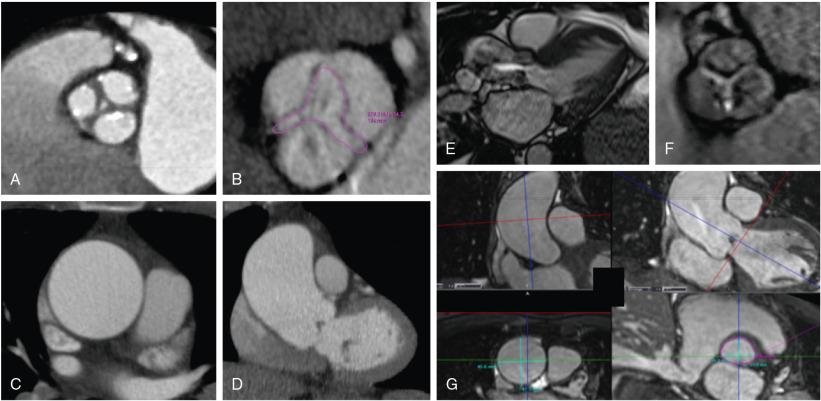
Bicuspid aortic valves (BAVs) are the most common congenital cardiovascular abnormality, affecting up to 2% of the population. Beyond the abnormal aortic valve morphology, which can facilitate early degeneration (i.e., stenosis and regurgitation), patients with BAV can also have other associated conditions, such as aortopathy involving the aortic root or thoracic aorta and aortic coarctation. Despite the aortopathy, BAV patients tend to have a small risk of aortic dissection compared with other cohorts with connective tissue disorders. ,
BAVs typically have a single line of coaptation, which extends to the sinotubular junction at both ends with two well-defined interleaflet triangles. Unicuspid valves have a single line of coaptation, which extends from the STJ to the centroid of the valvar orifice with a single, well-defined, interleaflet triangle between the noncoronary and left coronary leaflets.
Valvar morphology assessment by echocardiography requires on-axis imaging from the short-axis views of the aortic valve. Distinguishing a raphe from a functional zone of apposition is difficult in diastole. Imaging the valve from the short-axis view in systole allows appreciation of the zones of apposition versus fusion of the cusps.
For patients with good-quality transthoracic images, who do not have dense bicuspid aortic valve calcification, diagnostic sensitivity and specificity are more than 70% and 90%, respectively. , However, diagnostic uncertainty may remain for 10% to 15% of patients after an echocardiogram. Particularly in the setting of calcification, color Doppler in systole may be helpful in distinguishing immobile trileaflet aortic valves without commissural fusion from bicuspid valves with fusion ( Fig. 8.6 ). TEE and 3D modalities significantly improve the diagnostic and phenotyping accuracy for BAVs.

Several classification systems have been used in the past. Most were based on the fusion of cusps and orientation or number of the raphae. Some of these classification systems then identified patients with no raphe as pure BAV or type 0. One classification system identifies only two BAV phenotypes: fusion of the right and left coronary cusps (BAV-AP) and fusion of the right or left coronary cusp and noncoronary cusp (BAV-RL). These two phenotypes have some support from animal studies identifying defective development of different embryologic structures.
Morphology may provide valuable data regarding risk stratification of BAV patients. , , In a small population of 167 patients, Kang et al showed that moderate-to-severe aortic stenosis (AS) is more prevalent among patients with BAV-RL (66.2% vs. 46.2% in BAV-AP; P = 0.01), and moderate-to-severe AR is more prevalent among patients with in BAV-AP (32.3% vs. 6.8% in BAV-RL; P < 0.0001). The association with bicuspid aortic valve and dilation of the ascending aorta has been well-established. Some investigators have suggested that the aortic abnormality is unrelated to the valvular pathology , and a primary anomaly is associated with this entity.
For a comprehensive evaluation of BAV morphology and function, in addition to other associated conditions, cross-sectional imaging with gated CTA or CMR is necessary. , Table 8.1 summarizes the advantages and disadvantages of each cross-sectional imaging method.
| Modality | Advantages | Disadvantages |
|---|---|---|
| Echocardiography | Readily available and portable Transthoracic and transesophageal approaches No iodinated intravenous contrast No radiation Excellent temporal resolution Good spatial resolution Functional and hemodynamic information Automated postprocessing tools are becoming available |
Requires adequate training and technical skills for comprehensive examination Potentially more skill required for 3D and annular assessment Transesophageal echocardiography is semi-invasive, and sedation typically required Limitations of ultrasound physics (e.g., acoustic shadowing, far-field imaging) can compromise interpretation Lateral resolution × frame rate issues |
| Computed tomography | Excellent spatial resolution (gold standard for anatomic information and structural planning) Noninvasive and fast Comprehensive vascular assessment Easy to use/familiarity Automated postprocessing tools are available with comprehensive vascular assessment |
Frequently requires iodinated intravenous contrast (elevated risk for patients with chronic kidney dysfunction) Radiation dose has improved, but high in 4D (functional) CT Poor temporal resolution (better with dual-source CT) Suboptimal in patients with increased heart rate/arrhythmia Not portable Blooming artifacts can occur with calcium, valve stent frames, intracardiac leads, and other conditions |
| Cardiac magnetic resonance | Good temporal and spatial resolution Minimal effect of body habitus Gold standard for ventricular volumes, mass, and ejection fraction (no contrast required) Excellent for valvular regurgitation (no contrast) Excellent myocardial tissue characterization No radiation and noninvasive Can assess anatomy without intravenous gadolinium Vascular assessment Hemodynamic information |
Spatial resolution inferior to CT and 3D TEE (thick slices) Lower temporal resolution than echocardiography Requires adequate training for comprehensive examination acquisition and interpretation Longer examination (free-breathing cardiac magnetic resonance examination is possible) Claustrophobia Incompatible with certain intracardiac devices and cardiac resynchronization therapy; cases of older prosthesis–patient mismatch Suboptimal quantification can occur with fast and irregular cardiac arrhythmia (unless newer pulse sequences are available) Cannot visualize calcification well Peak velocities may be underestimated |
Although TTE is adequate for screening, cross-sectional imaging is required to guide timing of surveillance and aortic intervention. Cardiac gated CTA and CMR are the best imaging modalities due to their exquisite spatial resolution and 3D imaging reconstruction capabilities. To provide accurate measurements, adequate postprocessing using multiplanar reformatting with double oblique reconstructions is necessary. The thresholds for intervention and discussion of BAV outcomes can be found in Chapter 11 .
Studies using advanced imaging techniques with 4D flow CMR have suggested that hemodynamic factors such as regional wall stress in the setting of eccentric outflow patterns contribute to the pattern of aortic dilation.
The stages of valvular AS are defined by symptoms, valve hemodynamics, and the effect of valve obstruction on ventricular structure and function. Echocardiography remains the initial imaging modality for the diagnosis, phenotyping, and hemodynamic assessment of aortic valve dysfunction and the initial assessment of the thoracic aorta ( Table 8.2 ). CTA and CMR have become important adjunctive imaging modalities for the evaluation of patients with AS, giving the growing complexity in assessing this valve pathology.
| Mild | Moderate | Severe | |
|---|---|---|---|
| Valve Anatomy | |||
| Mild-to-moderate leaflet calcification of a bicuspid or trileaflet valve with some reduction in systolic motion or Rheumatic valve changes with commissural fusion |
Severe leaflet calcification or congenital stenosis with severely reduced leaflet opening | ||
| Quantitative Parameters (Flow Dependent) | |||
| Peak velocity | <3 m/s | 3–4 m/s | >4 m/s |
| Mean gradient | <20 mmHg | 20–40 mmHg | >40 mmHg |
| Quantitative Parameters (Flow-Independent) | |||
| Doppler velocity index | >0.5 | 0.25– 0.5 | <0.25 |
| Aortic valve area (AVA) | >1.5 cm 2 | 1.0–1.5 cm 2 | <1.0 cm 2 |
| AVA index | >0.85 cm 2 /m 2 | 0.6–0.85 cm 2 /m 2 | ≤0.6 cm 2 /m 2 |
According to guidelines, TTE is indicated when there is an unexplained systolic murmur, a single second heart sound, a history of a bicuspid aortic valve, or symptoms that may be due to AS. , The evaluation of aortic valve area (AVA) should include direct visualization, planimetry, and Doppler assessment. Doppler echocardiography assessment of AS can be categorized as flow-dependent measurements or flow-independent measurements. Flow-dependent measurements obtained from continuous-wave Doppler across the stenotic aortic valve, include jet velocity and peak and mean gradients. Relatively flow-independent measurements of aortic valve area include the AVA calculated from the continuity equation and the dimensionless velocity or velocity-time integral (VTI) ratio, also known as the dimensionless index (DI).
Direct visualization and estimation of location and severity of valve calcification (i.e., leaflet tips, commissures or sinuses of Valsalva) and mobility of the leaflets should not be underestimated as a tool for assessing AS severity.
Direct planimetry of a stenotic aortic orifice has been validated. Okura et al evaluated the reliability of 2D TTE AVA planimetry by comparing the planimetered inner leaflet edges from short-axis views at the time of maximal opening (i.e., early systole) with similar measurements made on TEE and with valve area by the continuity equation and the Gorlin formula. Correlation was high (r = 0.98, 0.9, and 0.89, respectively) with a very low standard error of the estimates (0.04 cm 2 , 0.09 cm 2 , and 0.10 cm 2 , respectively). Multiple studies have suggested that 3D planimetered AVA is larger than 2D measurements, , but 3D measurements showed a lower mean difference with continuity equation calculations.
In clinical practice, direct 2D planimetry using 2D TTE is not always feasible due to difficult windows and visualization of the aortic valve opening. The significant upward motion of the aortic annulus in systole makes it harder to define whether the plane is at the leaflet tips. In these instances, use of simultaneous biplane imaging to define the short-axis level of the leaflet tips, or direct planimetry using 3D multiplanar reconstruction, may be helpful.
The maximum velocity of blood flow across the aortic valve (V max ) is measured by continuous-wave Doppler and is an important measure of AS disease severity. Natural history studies have shown that outcomes are determined by peak transaortic velocity, with progressively worse survival correlating with increasing velocities above 4 m/s. The change in velocity over time is another parameter that predicts outcome. Rosenhek et al found that in patients with moderately or severely calcified aortic valves whose aortic jet velocity increased by 0.3 m/s or more within 1 year, 79% underwent surgery or died within 2 years.
The pressure gradient across the valve (ΔP) is related to V max , the proximal velocity (V prox ), and the mass density of blood (ρ) , as stated in the Bernoulli equation, which includes terms for conversion of potential to kinetic energy (i.e., convective acceleration), the effects of local acceleration, and viscous (v) losses:
where dv/dt is rate of change in velocity over time; dx is the time-varying velocity at each distance along the flow stream; and R is a constant describing the viscous losses for that fluid and orifice.
In clinical practice, the terms for acceleration and viscous losses are ignored, and ½ ρ is converted to allow pressure to be measured in mmHg and velocity in m/s, so that
When the proximal velocity is low (<1.5 m/s) and the jet velocity is high (V prox 2 << V max 2 ), the equation can be further simplified as the modified Bernoulli equation:
The assumptions of the modified Bernoulli equation may not be valid in some circumstances (i.e., severe anemia, dynamic LVOT obstruction, or concomitant subvalvular stenosis when the proximal velocity cannot be assumed to be negligible).
Maximum instantaneous transaortic gradient is calculated from the maximum transvalvular velocity, whereas the mean gradient is calculated by averaging the instantaneous gradient over the systolic ejection period. A mean gradient of more than 40 mmHg is considered severely increased and is associated with a peak velocity of 4 m/s. However, large population-based studies have shown that the AVA cutpoint of 1.0 cm 2 corresponds to a mean gradient of 30 to 35 mmHg.
Underestimating V max (and pressure gradient) most frequently occurs in the setting of a nonparallel intercept angle between the continuous-wave Doppler beam and the direction of blood flow. Because of the asymmetric nature of the aortic root, with the greatest stress on the right and noncoronary cusps, greater calcification, particularly of the noncoronary cusp, may occur. In addition to asymmetric calcification, acute angulation of the aortic root, which may be more prevalent in the elderly, is associated with anteriorly directed transaortic jets that can be best imaged from nonapical windows ( Fig. 8.7 ). , Studies have shown that the V max was most frequently obtained in the right parasternal window (50%), followed by the apical windows (39%).
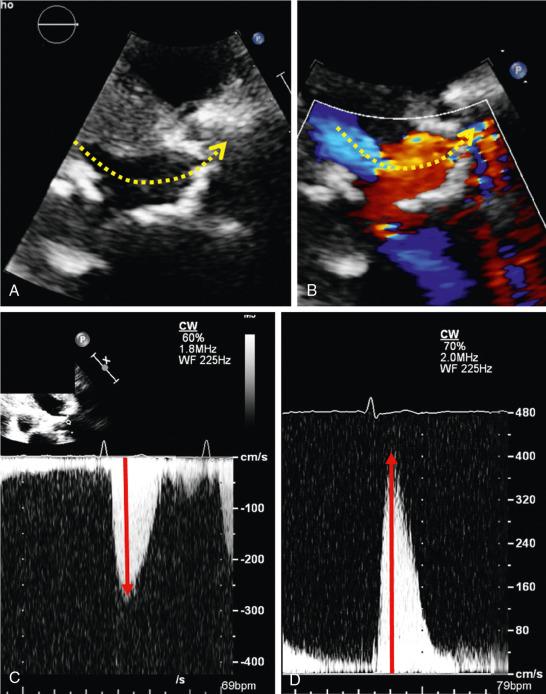
Patients with an acute LV–aortic root angle measured in the parasternal long-axis view, which is frequently seen with basal septal hypertrophy, had V max obtained from the right parasternal window more frequently than from apical windows (65% vs. 19%). Failure to capture the nonapical window V max resulted in misclassification of the AS grade in 8% to 15% of patients. A multiwindow Doppler assessment is mandatory. To optimize the angle of insonation, a dedicated small dual-crystal continuous-wave Doppler transducer is frequently used.
Other sources of error in measuring V max include incorrect identification of the flow signal (e.g., mistaking the mitral regurgitation signal for AS), respiratory motion, and measurement variation. Because velocity and gradient depend on flow, several physiologic situations can result in low-velocity/gradient, severe AS, including: tachycardia, bradycardia, hypertension, small ventricular cavity, severe diastolic dysfunction, severe mitral or tricuspid valve disease, pulmonary hypertension, and left or right ventricular dysfunction.
The flow-independent hemodynamic measurements of AVA include the AVA calculated from the continuity equation and the Doppler index. The continuity equation is based on the conservation of mass principle, in which flow across any region of a continuous tube should be the constant. The stroke volume across the LVOT should be the same as the stroke volume across the aortic valve ( Fig. 8.8 ). Because stroke volume is the product of cross-sectional area (CSA) and the velocity-time integral of flow (VTI), the stroke volume (in ml) across the LVOT (SV LVOT ) is calculated as
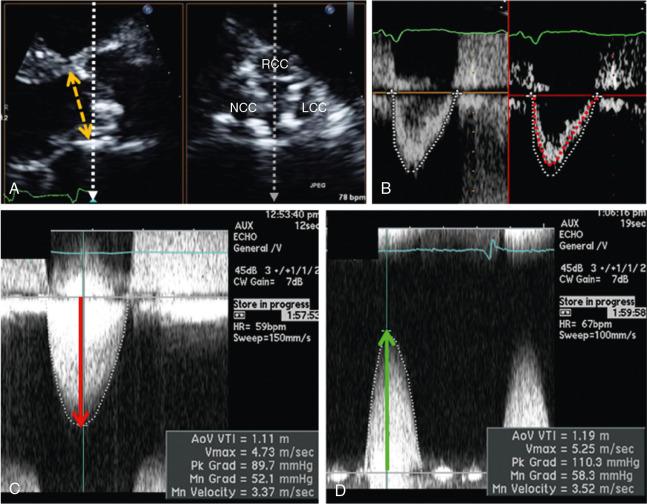
where CSA LVOT is the LVOT CSA in cm 2 and VTI LVOT is the stroke distance (measured as the VTI) in cm at the LVOT by pulsed-wave Doppler. The CSA LVOT is calculated as π(D/2) , where D is the diameter of the LVOT. Likewise, SV aortic valve is calculated as
where AVA is given in cm 2 and VTI aortic valve is the stroke distance (measured as the VTI) in cm across the aortic valve by continuous-wave Doppler. Because SV LVOT = SV aortic valve , solving for AVA results in the continuity equation:
Because the cardiac output required in an individual depends on body size, indexing the AVA to body surface area (BSA) is another important measure of severity. Obese patients may not require the same amount of cardiac output as nonobese patients, and the American Society of Echocardiography reported that indexing the valve area is particularly important in smaller patients with a height < 135 cm (<65 inches), a BSA < 1.5 m 2 , or a body mass index (BMI) < 22 kg/m 2 using an indexed AVA of ≥ 0.6 cm 2 /m 2 to define severe AS.
The greatest potential for error in the calculation of the AVA is the measurement of the LVOT diameter in systole because the assumption of the continuity equation is that the LVOT cross-sectional area is circular and this single dimension is squared to calculate the LVOT area. The LVOT diameter is measured by 2D TTE at peak systole, when the elliptical LVOT is more circular.
There are two additional important caveats for measurement of the LVOT. First, although current echocardiographic guidelines recommend measuring the LVOT diameter 5 to 10 mm below the annulus to correlate with the location of the pulsed-wave sample volume, studies comparing 2D TTE and cardiac catheterization showed that calculation of the AVA using LVOT diameter measured below the aortic annulus underestimates catheter-derived AVA. , AVA calculated with LVOT diameter measured at the level of the aortic annulus is more accurate, in part because the LVOT is more elliptical apical to the annulus.
Second, the correct long-axis imaging window should bisect the maximum diameter of the aorta, and simultaneous multiplane imaging using simultaneous multiplane imaging allows imaging of the short-axis and long-axis planes to ensure imaging of the correct plane ( Fig. 8.9 ). The right coronary cusp hinge point is imaged anteriorly, and the fibrous interleaflet trigone is imaged posteriorly. With appropriate gain and processing adjustments, the LVOT diameter is measured in the parasternal long-axis view using a zoomed freeze-frame at early to mid-systole, inner edge to inner edge, from where the anterior cusp meets the ventricular anteroseptum to the posterior virtual annulus, where the posterior interleaflet triangle meets the anterior mitral leaflet. Because there is no anatomic marker for the virtual annular plane within the interleaflet trigone, the correct annular diameter is measured by assuming the virtual annulus is approximately perpendicular to the long-axis of the aorta. Calcification of the scalloped lines of leaflet attachment within the sinuses (and defining the borders of the interleaflet trigone) should not be mistaken for the hinge point of the aortic cusp.
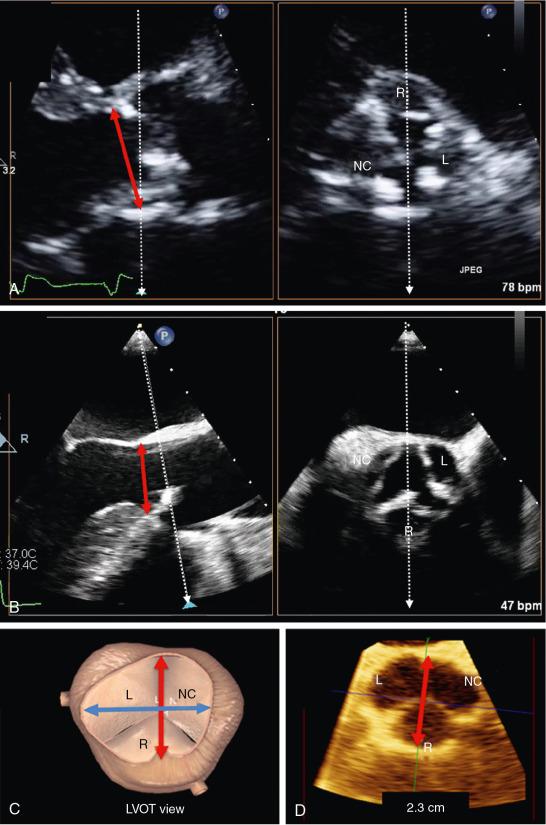
Although echocardiographic guidelines recommend a single-diameter measurement of the LVOT to calculate AVA, planimetry of the valve orifice and LVOT area by real-time 3D (RT3D) methods has been shown to be accurate and reproducible, , , and they compare favorably with CTA. , Studies have shown that the LVOT is elliptical , , and that the long-axis (sagittal) plane diameter derived from 2D images may underestimate the true LVOT dimensions. Compared with CTA, 2D echo may underestimate LVOT area and therefore the AVA. ,
Studies comparing standard 2D linear measurements with 3D planimetry of LVOT area show a 10% to 23% underestimation of cardiac output or AVA using 2D TTE or TEE modalities. , However, other studies suggest that CTA overestimates the LVOT area compared with CMR imaging or 3D echo. In a head-to-head comparison of CTA and Doppler echocardiography, Clavel et al showed that CTA for AVA calculation did not improve the correlation with transvalvular gradient, the concordance gradient-AVA, or mortality prediction compared with echocardiographic AVA.
Thresholds for excess mortality differ between imaging modalities: AVA ≤ 1.0 cm 2 for echocardiographic methods versus ≤1.2 cm 2 for CTA methods. There are strong outcomes data using traditional 2D methods of measuring LVOT and calculating AVA. , The LVOT should be measured in systole from the clearest image that yields the largest diameter, excluding ectopic calcifications, at or very close to the level of the aortic annulus and distal to any septal bulge.
In the setting of unreliable LVOT measurement data, using just the Doppler measurements in the continuity equation provides a more accurate measure of AVA severity and is associated with aortic valve events defined as aortic valve replacement, congestive heart failure due to AS, or death from cardiovascular causes. Wiggers reported decades ago that significant obstruction to flow occurred when a tube became limited to one third of its normal area, and this principle is reflected in the Doppler index, defined as the ratio of VTI LVOT /VTI aortic valve or V LVOT /V max . Normal valve areas have a Doppler index of slightly less than 1, and a value of less than 0.25 indicates severe stenosis. This index number is highly reproducible, simplifies the assessment of AS severity, and normalizes for body size because it represents the ratio of actual to expected valve area in each patient.
The next most common error is failure to correctly position the pulsed-wave Doppler sample volume and measure the modal velocity of LVOT flow ( Fig. 8.10 ). Because of flow acceleration just proximal to the stenotic orifice, current guidelines suggest that the pulsed-wave sample volume be placed just apical to this region of turbulent flow. The VTI should be measured from the modal velocity, which is the most frequently sampled velocity in a spectral profile. To trace the VTI LVOT , gains may need to be reduced so that only the densest spectral profile is seen.
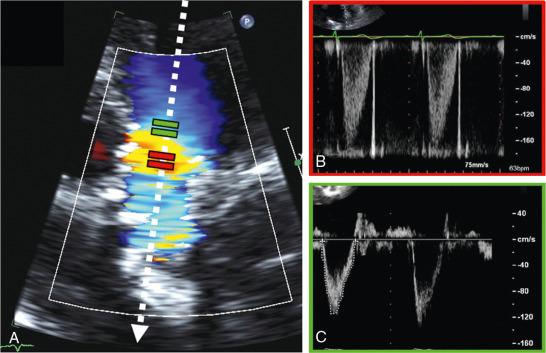
Severe AS according the American College of Cardiology (ACC) guidelines is ≤1.0 cm 2 , but this Gorlin-derived area cutoff represents the anatomic valve area. Doppler echocardiography measures the vena contracta of the transaortic jet stream, which typically is smaller than the anatomic valve area. Nonetheless, numerous studies have shown that a continuity equation valve area of ≤1.0 cm 2 predicts outcomes and remains a reliable tool for diagnosis and management of these patients. ,
Become a Clinical Tree membership for Full access and enjoy Unlimited articles
If you are a member. Log in here